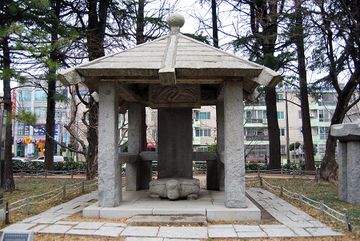유원각선생 매안감고비 및 비각
| 유원각선생 매안감고비 및 비각 |
|
 유원각선생 매안감고비 및 비각, 국가문화유산포털, 문화재청. |
|
| 대표명칭 | 유원각선생 매안감고비 및 비각 |
|---|---|
| 한자 | 柔遠閣先生 埋案感古碑 및 碑閣 |
| 주소 | 부산광역시 남구 유엔평화로 63 |
| 지정(등록) 종목 | 부산광역시 유형문화재 제48호 |
| 지정(등록)일 | 2001년 10월 25일 |
| 분류 | 기록유산/서각류/금석각류/비 |
| 시대 | 조선시대 |
| 수량/면적 | 1기 |
| 웹사이트 | 유원각선생 매안감고비 및 비각, 국가문화유산포털, 문화재청. |
|
|
|
해설문
국문
유원(柔遠)이란 ‘멀리 있는 것을 회유한다’는 뜻으로 일본에 대한 조선의 교린(交隣) 외교 정책을 뜻한다. ‘선생’은 일본과의 외교 업무에 종사한 조선 시대 동래부에 소속된 소통사(小通事)*를 일컫는 말로, 후손들이 이들의 명단과 업적을 잊지 않고 기리기 위해 광무 10년(1906) 옛터에 집을 지어‘유원각’이라 칭하고 비를 세운 것이다.
비문에는 비를 세운 목적과 비를 세운 사람들의 이름 등이 새겨져 있어 조선 후기 왜관(倭館)**과 개항기 부산의 역사 및 한일 관계사 등의 연구에 중요한 자료로 평가된다. 또한 비를 보호하는 비각은 돌로 만든 집의 형태를 취하고 있으며, 비각의 모양과 짜 맞추는 방법도 전통적인 것과 매우 달라서 건축학적으로도 주목된다.
이 비는 원래 부산광역시 동구 초량동 754-17번지 산 중턱의 가정집 마당에 있었으나 2000년 9월 지금의 자리로 옮겼다. ‘매안(埋安)’은 선조의 신주나 물건을 묘소 앞에 묻는 것을 말하므로 박물관에서는 비를 옮길 때 땅 속에 묻혀 있을지도 모를 선생안(先生安) 등 관련 서류를 찾기 위해 조사했으나 아무 것도 찾지 못하였다.
- 소통사(小通事): 조선 후기 하급 일본어 통역관
- 왜관(倭館): 조선 시대 일본과의 외교와 무역을 위해 일본인이 살 수 있도록 만든 공간
영문
Stele and Pavilion for the Interpreters of Yuwongak Hall
This stele honors the service of low-rank Japanese-language interpreters affiliated with the local government of Dongnae (in today’s Busan) who conducted diplomatic relations with Japan during the late period of the Joseon dynasty (1392-1910). It was erected in 1906 by their descendants.
During the Joseon period, there was a place in Busan called Waegwan where Japanese emissaries and merchants resided. It was considered a center of diplomatic, commercial, and cultural exchange between Korea and Japan. Yuwongak Hall was a government office in the Waegwan area which handled diplomatic relations with Japan. Its name means "a hall to appease that which is far," summarizing Korea's policy toward its neighbor. Interpreters dispatched from the capital by the central government carried out their duties in Yuwongak with the assistance of local low-rank interpreters from Busan. These low-rank officials used their Japanese language skills to perform various administrative work, such as surveilling the traffic of Japanese visitors, controlling the incoming and outgoing peddlers, and issuing supplies to Japanese emissaries.
This stele and its pavilion were moved to the Busan Museum in 2000 from the yard of a private house in Choryang-dong. The inscription on the stele honors the contribution of the local Busan interpreters in diplomatic relations with Japan and bears a promise that their descendants, who were granted permission to pursue a governmental career thanks to their ancestor's service, will not forget this great favor. The stele is also inscribed with the names of the descendants who erected it.
The pavilion housing the stele is made entirely of stone, which is rare, as most protective pavilions are made primarily of wood.
영문 해설 내용
조선 후기 일본과의 외교 업무에 종사한 동래부(지금의 부산 지역) 소속 하급 일본어 통역관들의 업적을 기리기 위해 1906년 후손들이 세운 비석이다.
조선시대 부산 지역에는 일본인 사신과 상인 등이 상주하던 왜관이 있었으며, 조선과 일본 양국의 외교, 무역, 문화 교류의 중요한 통로가 되었다. 유원각은 당시 대일외교를 담당하던 관청의 이름이며, ‘유원’은 ‘멀리 있는 것을 회유한다’는 뜻으로 일본에 대한 조선의 외교 정책을 나타낸다. 이곳에는 중앙정부에서 파견되는 역관들이 있었는데, 부산 현지 출신의 하급 통역관들이 이들의 업무를 보좌했다. 이 하급 통역관들은 일본어 실력을 바탕으로 일본인 왕래 감시, 잡상인 출입 단속, 일본 사신들에게 지급되는 물자 관리 등 여러 실무를 담당하였다.
이 비석과 비각은 원래 초량동의 한 가정집 마당에 있었으나 2000년 지금의 자리인 부산박물관으로 옮겼다. 비문에는 외교 업무에 종사한 선조들의 업적을 기리고, 그 은덕으로 후손들이 벼슬길에 나갈 수 있었던 것을 영원히 잊지 않겠다는 내용이 담겨 있다. 비를 세운 후손들의 이름도 새겨져 있다.
일반적으로 비석의 보호각은 목조로 지어지는데, 이처럼 비각 전체가 돌로 만들어진 것은 매우 독특한 사례이다.